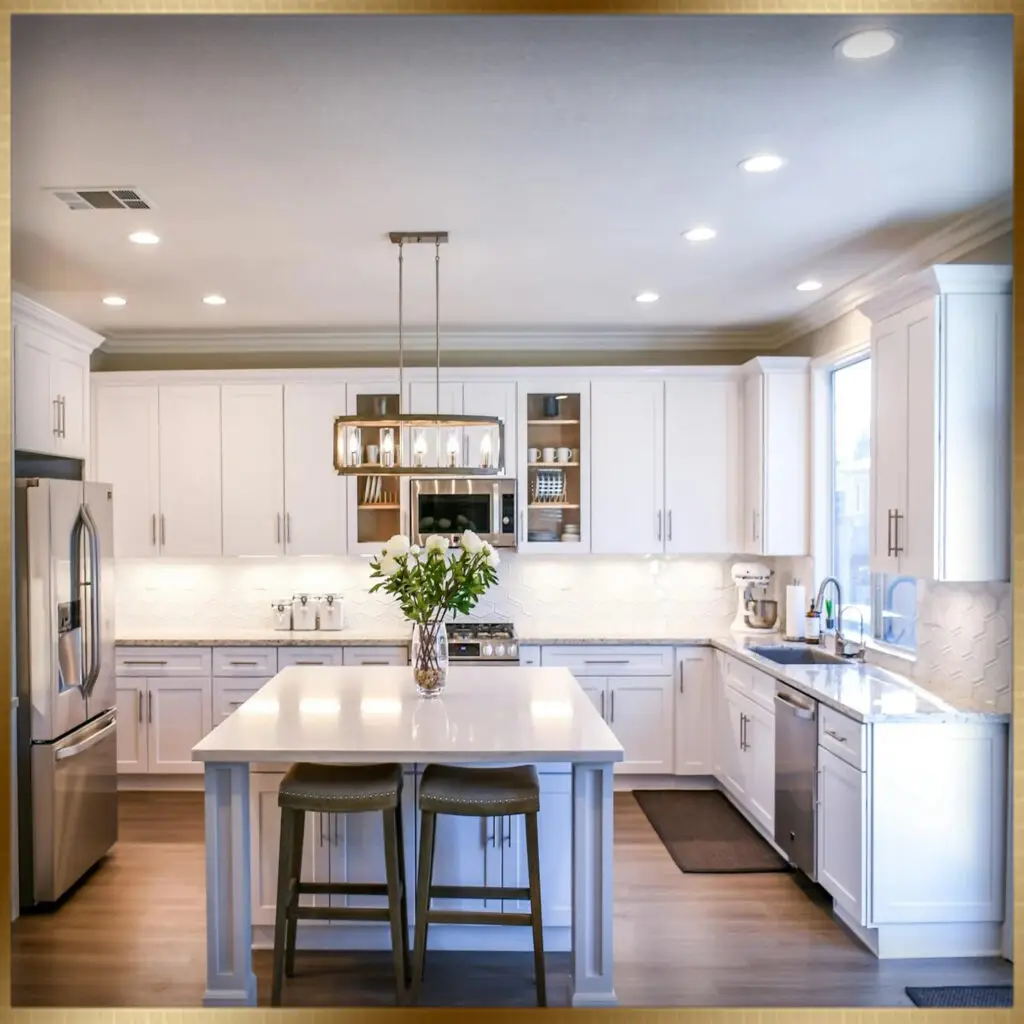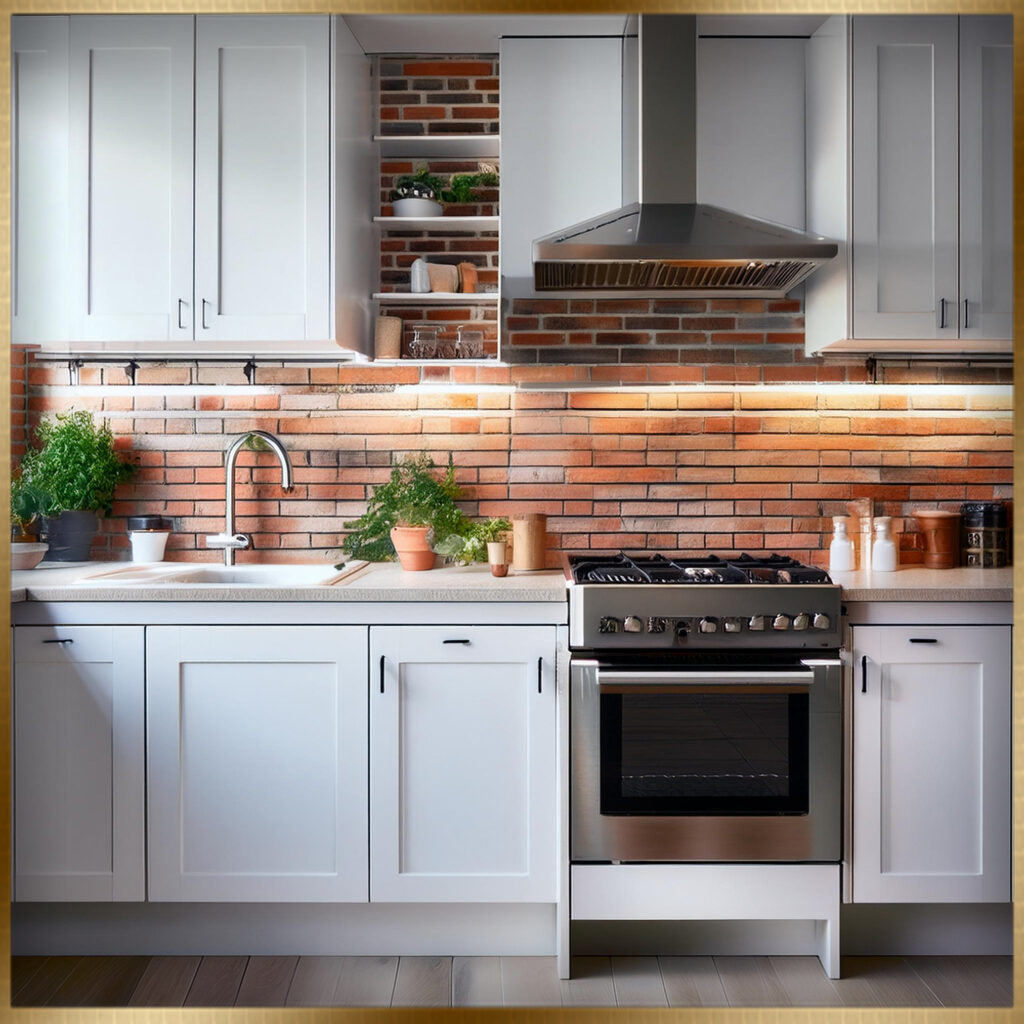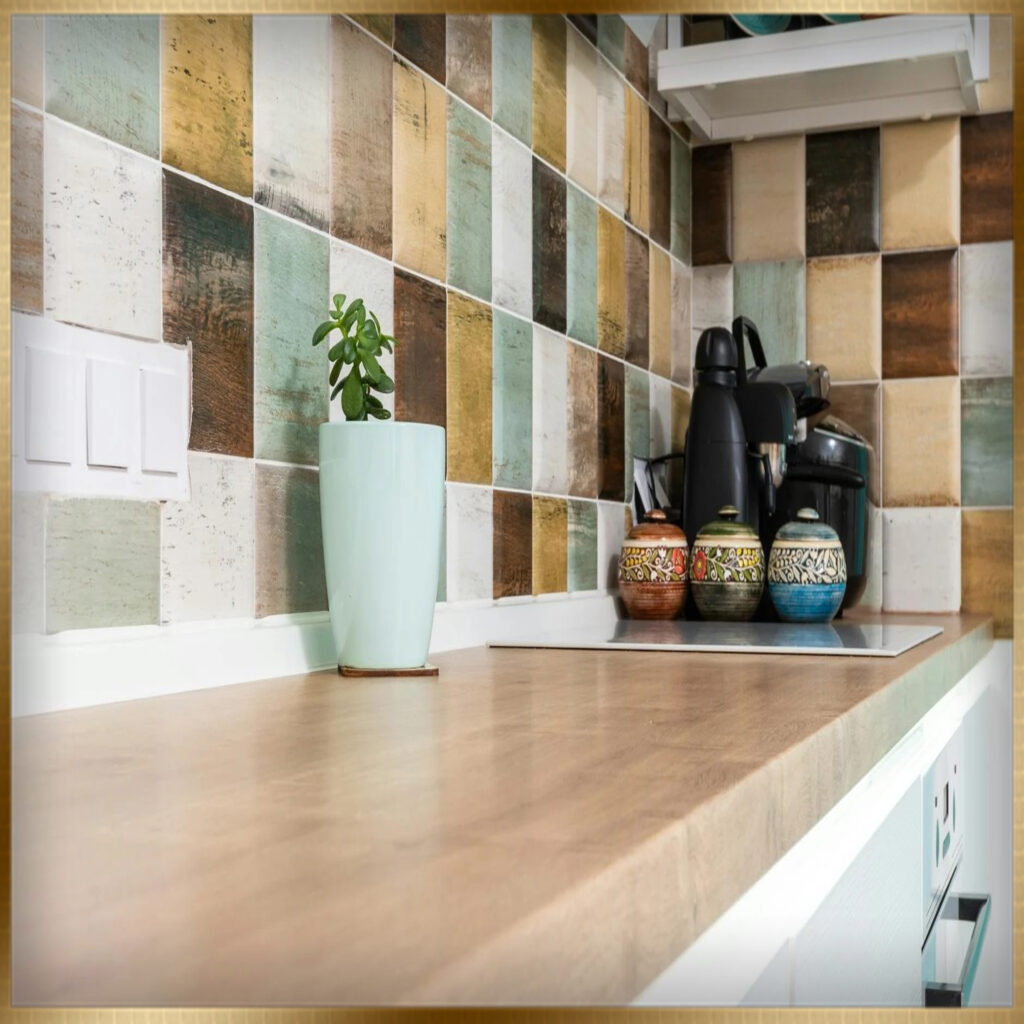
Are you tired of staring at bland kitchen walls? 🥱 Imagine a warm, rustic, inviting haven of a kitchen. Enter the world of brick backsplashes. This design trend is storming kitchens! 🧱✨
Brick backsplashes work with any style, from industrial chic to farmhouse. They add character and texture to kitchens. With so many options, how do you pick the perfect brick backsplash for your kitchen? Don’t worry – we’ve got you covered!
This guide will cover brick backsplashes. We’ll discuss their benefits, types, and design ideas. We’ll also give tips on installation, maintenance, and budgets. Our expert tips will help you create your dream kitchen, whether you DIY or hire a pro. Let’s enhance your kitchen’s style with the timeless charm of brick!
Benefits of Brick Backsplashes for Kitchens

Brick backsplashes are great for kitchen design. They’re popular with homeowners and designers. Let’s explore the key benefits:
A. Versatility in design options
Brick backsplashes provide endless possibilities for customization:
-
Color variations: From classic reds to modern whites and grays.
-
Textures: Smooth, rough, or distressed finishes.
-
Patterns: Herringbone, running bond, or basket weave.
| Pattern | Description | Visual Impact |
| Herringbone | V-shaped pattern | Adds dynamic movement |
| Running Bond | Staggered horizontal rows | Creates a classic look |
| Basket Weave | Alternating vertical and horizontal bricks | Offers a unique texture |
B. Heat and moisture resistance
Brick is a great choice for kitchen backsplashes. Its natural properties make it ideal.
-
Withstands high temperatures from cooking.
-
Resists moisture and splashes.
-
Prevents mold and mildew from growing.
C. Durability and easy maintenance
Brick backsplashes are built to last:
-
Resistant to scratches and chips.
-
It is easy to clean with a wipe or a scrub.
-
Looks good for years with little upkeep.
D. Timeless aesthetic appeal
Brick backsplashes have a timeless charm. They suit various kitchen styles.
-
Adds warmth and character to modern kitchens.
-
Enhances rustic or farmhouse-inspired designs.
-
Creates a focal point in minimalist spaces.
These benefits make it clear. Brick backsplashes are popular in kitchen renovations. Let’s now explore the types of brick backsplashes. We’ll find one that suits your design preferences.
Types of Brick Backsplashes

We’ve seen the benefits of brick backsplashes. Now, let’s explore the types available for your kitchen. Each type has a unique look. It can transform your space.
A. Traditional Red Brick
Red brick backsplashes are warm and rustic. They charm. They add a timeless, classic look to any kitchen. They are ideal for farmhouse or industrial designs.
B. Whitewashed Brick
Whitewashed brick is softer and more modern. This technique involves applying a thin layer of white paint to the brick. It should let some natural color show for a shabby-chic, weathered look.
C. Reclaimed Brick
Reclaimed brick is perfect for those who want a unique, green option. These bricks, salvaged from old buildings, will add a unique look to your kitchen. They also add history.
D. Faux Brick Tiles
Faux brick tiles look like real brick. But, they are lighter and easier to install. They are usually porcelain or ceramic. They come in many colors and finishes.
E. Glazed Brick
Glazed brick has a sleek, modern twist on the classic brick look. These bricks come in many colors. They have a glossy finish that’s stylish and easy to clean.
| Type | Appearance | Durability | Maintenance | Cost |
| Traditional Red Brick | Rustic, warm | High | Moderate | Moderate |
| Whitewashed Brick | Soft, contemporary | High | Low | Moderate |
| Reclaimed Brick | Unique, characterful | High | Moderate | High |
| Faux Brick Tiles | Varied, customizable | Moderate | Low | Low to Moderate |
| Glazed Brick | Modern, glossy | High | Low | High |
Next, we will explore some inspiring designs. They will help you make the most of your chosen brick backsplash type.
Design Ideas for Brick Backsplashes
We’ve covered the types of brick backsplashes. Now, let’s look at some design ideas to inspire your kitchen renovation.
A full-wall brick backsplash.
A full-wall brick backsplash is a stunning focal point in your kitchen. This bold choice adds depth and texture. It transforms your kitchen into a warm, inviting space. Use reclaimed bricks for a rustic, vintage appeal. Use sleek, modern bricks for a contemporary look.
B. Herringbone pattern
The herringbone pattern adds a stylish, deep look to your backsplash. It’s brick. This design is classic. It creates a sense of movement and can make your kitchen seem larger. Here’s a comparison of herringbone layouts:
| Pattern | Description | Best suited for |
| 45-degree | Classic, diagonal layout | Traditional kitchens |
| 90-degree | Vertical zigzag pattern | Modern, urban spaces |
| Double | Two bricks side by side | Large backsplash areas |
C. Contrasting grout colors
Test grout colors to improve your brick backsplash.
-
White grout: Creates a clean, fresh look.
-
Dark grout: Emphasizes the brick pattern.
-
Colored grout: Adds a unique, personalized touch.
D. Mixed materials with brick accents
For a unique backsplash, mix brick with other materials.
-
Brick and subway tiles
-
Brick and stainless steel
-
Brick and glass mosaic tiles
-
Brick and natural stone
This mixed-material approach lets you use the warmth of brick. It keeps a modern look. For example, use brick as an accent strip in a tile backsplash. Or, frame a section of decorative tiles with brick borders.
Next, we’ll look at some key tips for installing your brick backsplash.
Installation Considerations
When installing a brick backsplash in your kitchen, keep a few key factors in mind. A proper installation will keep your backsplash beautiful and long-lasting. So, it’s crucial to pay attention to the details.
Grout Selection and Application
Choosing the right grout is vital for your brick backsplash. It affects both its look and its function. Consider the following options:
-
Sanded grout: Ideal for wider joints (1/8 inch or more).
-
Unsanded grout: Best for narrower joints (less than 1/8 inch).
- Epoxy grout: Highly durable and stain-resistant
| Grout Type | Pros | Cons |
| Sanded | Durable, less shrinkage | Can scratch delicate surfaces |
| Unsanded | Smooth finish, easy to apply | Less durable for wider joints |
| Epoxy | Stain-resistant, waterproof | More expensive, difficult to apply |
Proper Surface Preparation
Before installing your brick backsplash, make sure the surface is:
-
Clean and free of debris.
-
Dry and free of moisture.
-
Level and smooth
-
Properly primed, if necessary.
Sealing for Protection
Sealing your brick backsplash is crucial for:
-
Protecting against moisture
-
Preventing stains
-
Easing cleaning and maintenance.
After installation, apply a high-quality sealer. Reapply it following the manufacturer’s recommendations.
DIY vs. Professional Installation
DIY installation can save money. But, there are benefits to hiring a pro.
-
Expertise in surface preparation
-
Precise cutting and fitting of bricks.
-
Proper sealing and grouting techniques.
-
Time-saving and potentially less stressful.
When choosing between DIY and pro installation, weigh your skills, time, and budget. For complex designs, or if you’re unsure, hire a pro. This will ensure a perfect finish for your brick backsplash.
Now that we have installed it, let’s match your new brick backsplash with some kitchen styles.
Coordinating Brick Backsplashes with Kitchen Styles
Brick backsplashes are versatile. They suit any kitchen style. Let’s explore how to match brick backsplashes with various design styles.
Rustic and Farmhouse Kitchens
Brick backsplashes are a natural fit for rustic and farmhouse-style kitchens. Here’s how to make them work:
-
Use weathered or reclaimed brick for an authentic, aged look.
-
Opt for warm, earthy tones like red, orange, and brown.
-
Use a mix of wood and wrought iron accents.
-
Try a herringbone pattern for added visual interest.
Industrial and Modern Spaces
In industrial and modern kitchens, brick backsplashes add a nice touch. They add texture and character.
-
Select sleek, uniform bricks in neutral colors, like gray or white.
-
Try using geometric patterns or stack bond layouts.
-
Use a mix of stainless-steel appliances and concrete countertops.
-
Use dark grout for a bold, contrasting effect.
Transitional Kitchen Designs
In transitional kitchens, brick backsplashes can unite old and new styles.
-
Choose a mix of classic and modern brick styles.
-
Use neutral bricks. Add colorful accents in other elements.
-
Incorporate both smooth and textured brick finishes.
-
Pair with transitional fixtures and hardware.
Eclectic and Bohemian Interiors
In eclectic and bohemian kitchens, brick backsplashes can be unique. They can be a canvas.
-
Mix different brick colors and sizes for a playful look.
-
Use painted or glazed bricks for bright, colorful accents.
-
Combine bricks with tiles or mosaics.
- Add plants and hanging elements to boost the bohemian vibe.
| Kitchen Style | Brick Type | Color Palette | Complementary Elements |
| Rustic/Farmhouse | Weathered, reclaimed | Warm earthy tones | Wooden accents, wrought iron |
| Industrial/Modern | Uniform, sleek | Neutral grays, whites | Stainless steel, concrete |
| Transitional | Mix of classic and modern | Neutral with pops of color | Transitional fixtures |
| Eclectic/Bohemian | Mixed sizes, painted | Vibrant, varied | Plants, mixed materials |
Choose the right brick style and match it with other elements. It will create a stylish, cohesive kitchen design. It will show the timeless appeal of brick backsplashes. Next, we’ll share tips to maintain and clean your brick backsplash. They’ll keep it looking great for years.
Maintenance and Cleaning Tips
It’s vital to keep your brick backsplash beautiful and whole. This will ensure its long life and great looks. It covers everything from selecting to maintaining the brick backsplashes for kitchens and wallpaper. Here are some key tips to keep your brick backsplash looking its best:
Regular dusting and wiping.
To prevent dirt buildup, dust your brick backsplash often. Use a soft, dry cloth or a vacuum with a brush attachment. For routine cleaning, wipe the surface with a damp cloth and a mild soap solution. Be sure to dry the area. This will prevent moisture absorption.
Dealing with grease and stains.
Kitchen backsplashes tend to get greasy and stained by food. To tackle these:
-
Mix warm water with dish soap.
-
Apply the solution to the stained area with a soft brush.
-
Gently scrub in circular motions.
-
Rinse with clean water and dry thoroughly.
For tougher stains, create a paste using baking soda and water. Apply it to the stain, let it sit for 15 minutes, then scrub and rinse.
Resealing periodically
To prevent moisture and stains, reseal your brick backsplash every 1-2 years. Here’s a simple process:
| Step | Action |
| 1 | Clean the surface thoroughly |
| 2 | Allow the backsplash to dry completely |
| 3 | Apply a penetrating sealer with a brush or roller |
| 4 | Let it absorb for 10-15 minutes |
| 5 | Wipe off excess sealer |
| 6 | Allow 24 hours for full curing |
Avoiding harsh chemicals
Harsh cleaning products can damage the brick and grout. Avoid using:
-
Acidic cleaners (vinegar, lemon juice)
-
Abrasive scrubbers
-
Bleach-based products
Instead, use pH-neutral cleaners made for brick surfaces.
These tips will keep your brick backsplash a stunning focal point for years. Next, we’ll look at the costs. This will help you plan your brick backsplash project.
Cost Factors and Budget Considerations
When planning a brick backsplash for your kitchen, be aware of the costs and budget. Let’s explore the key aspects that will affect your costs.
Material Costs for Different Brick Options
Brick material costs can vary a lot. It depends on the type and quality you choose.
Installation Expenses
Sometimes, installation costs can exceed the cost of the materials. Factors affecting installation expenses include:
-
Labor rates in your area.
-
Complexity of the design
-
Preparation work is required.
-
Size of the backsplash area
On average, expect to pay $10 to $30 per square foot for installation.
Long-term value and durability
Brick backsplashes may cost more upfront. But, they last long and are always in style. So, they are a great value. Benefits include:
-
Resistance to heat and moisture.
-
Low-maintenance requirements
-
Potential to increase home values
When budgeting for your brick backsplash project, consider the costs. Also, think about the long-term benefits and savings on upkeep and replacements. With careful planning, you can make a great, inexpensive brick backsplash. It will enhance your kitchen’s look.
FAQs:
-
Are brick backsplashes for kitchens durable and easy to maintain? Yes, brick backsplashes for kitchens are durable but can be porous. To make them easier to clean and maintain, sealing the brick is recommended.
-
Can brick backsplashes for kitchens resist heat and moisture? Brick backsplashes for kitchens can handle heat. But, they may absorb moisture if unsealed. Using a proper sealant ensures longevity and resistance to kitchen conditions.
-
Do brick backsplashes for kitchens need special cleaning products? Mild cleaners and warm water are usually enough for brick backsplashes in kitchens. But, avoid abrasive chemicals that may damage the sealant or the brick itself.
-
How do I seal brick backsplashes for kitchens to protect them? You can apply a brick sealant that is specifically formulated for use in kitchens. This will protect the brick from moisture, grease, and stains. It will make the surface more durable and easier to clean.
-
What color options are available for brick backsplashes in kitchens? Kitchen brick backsplashes come in many shades. These include classic red, whitewashed, grey, and even black. Homeowners can match them to various design styles.
-
Can brick backsplashes for kitchens be used in modern-style kitchens? Yes, brick backsplashes for kitchens work well in both rustic and modern kitchens. In modern spaces, painted or whitewashed brick can provide a stylish contrast.
-
How do brick backsplashes for kitchens compare to tile backsplashes in terms of cost? Brick backsplashes for kitchens can be cheaper than some high-end tiles. But, costs vary by brick type and installation method. Faux brick options can offer budget-friendly alternatives.
-
Is it difficult to install brick backsplashes for kitchens by yourself? Installing real brick backsplashes in kitchens can be tough. Many homeowners hire pros to ensure the brick is set and sealed.
-
Can I use faux brick backsplashes for kitchens as a cheaper alternative? Faux brick kitchen backsplashes are a cheap and popular choice. They look like real brick. But, they are lighter, easier to install, and need less maintenance.
-
Will brick backsplashes for kitchens go out of style soon? Brick backsplashes for kitchens are timeless. They suit farmhouse, industrial, and rustic designs. But, trends like painted or whitewashed brick are more in style.
Conclusion:
Brick backsplashes are a kitchen design choice. They are timeless and versatile. They are both beautiful and practical. From traditional red brick to modern white, these backsplashes suit any kitchen. They fit any style or taste. Their durability, low maintenance, and charm make them a top choice for homeowners. They want to enhance their kitchens’ ambiance.
When choosing a kitchen brick backsplash, consider the installation, upkeep, and cost. A brick backsplash can transform your kitchen. It can make it a warm, inviting space that reflects your style. It will also be functional and last a long time. But, you must plan and execute it properly. If you’re renovating or building, explore the options. Create a kitchen that feels like home.
Ready to craft a stunning new kitchen?
If you’re thinking of a kitchen redo or a refresh, the brick backsplashes for kitchens is a timeless choice. It ensures your kitchen is comfortable, functional, and stylish—a space you’ll love to spend time in. Embrace the practicality of the brick backsplashes for kitchens and create a space that works for everyone.
If you’re searching for the perfect layout for your kitchen renovation, an expert kitchen designer can assist you in finding the ideal brick backsplashes for kitchens. Click here to connect with a Decor Cabinets designer in your area!
For more on home decor tips, visit us at decornest.online!